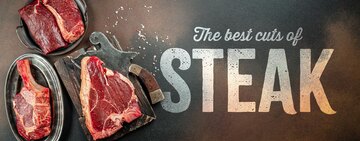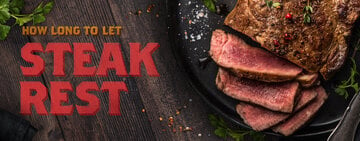Cooking the perfect steak is both an art and a science, and with so many methods available, it can be hard to know which one delivers the best results. Whether you crave the smoky char from a grill, the crusty sear of a hot pan, or the precise control of sous vide, each technique brings out unique flavors and textures. From traditional to modern approaches, mastering a variety of cooking methods can help you create a well-rounded menu with different cuts of steak.
1. Grill
Grilling is a favorite method for many, and for good reason. It’s fast, flavorful, and delivers consistent results. It applies direct, high heat - often over charcoal or wood - to sear the steak quickly and lock in its juices while creating a beautifully charred crust. The open flame also adds a smoky, unmistakable flavor that can’t be replicated on a stovetop or in the oven. Visually appealing grill marks and caramelization only add to the experience.
As with any of the methods, cooking time will vary based on the thickness of the steak and your preferred doneness. To get it just right, use a meat thermometer to check the internal temperature. If the steak is browning too quickly, lower the heat on a gas grill or move it to an indirect heat zone on a charcoal grill. Always oil the grates before preheating. This prevents sticking, makes flipping easier, and ensures that perfect sear every time.
- Grill Temperature for Steak: 450 degrees Fahrenheit
- How Long to Grill Steak: 2 to 4 minutes per side for medium-rare
- Best Steak for Grilling: Ribeye, New York strip, T-bone, porterhouse, flat iron, and filet mignon
2. Pan Sear
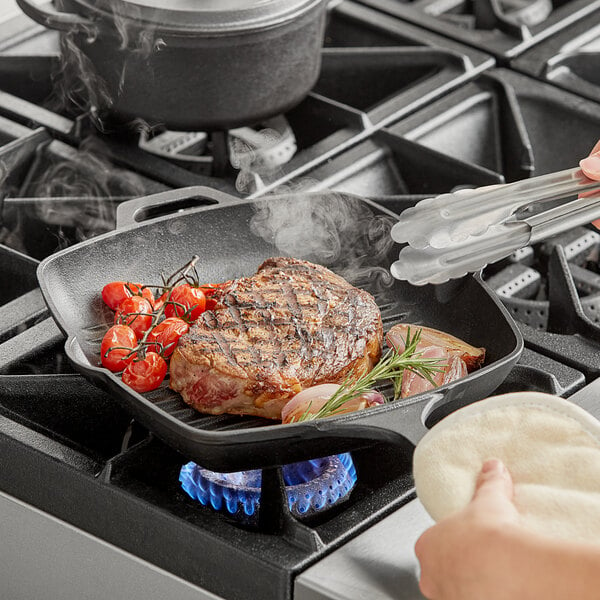
Pan searing is a popular method for cooking steak because it delivers a deeply caramelized crust and provides excellent control over temperature. Using a hot, heavy skillet, the steak cooks in its own rendered fat, developing a rich, golden-brown crust that enhances flavor and seals in juices. Well-marbled cuts are ideal for this method, as their intramuscular fat melts during cooking, adding depth and tenderness to every bite. To infuse the steak with extra flavor, add butter, garlic, and herbs toward the end for basting.
The best pans for searing steak are heavy and retain heat well. Cast iron is the gold standard - it’s affordable, durable, and excellent at creating a consistent, even crust. Carbon steel is an excellent alternative with comparable performance but a slightly lighter weight, while stainless steel can also be effective when properly preheated.
- Pan Temperature to Sear Steak: Medium-high to high heat
- How Long to Cook Steak in a Pan: 2 to 3 minutes per side for medium-rare
- Best Steak for Pan Searing: Ribeye, New York strip, filet mignon, sirloin, flat iron
3. Sous Vide
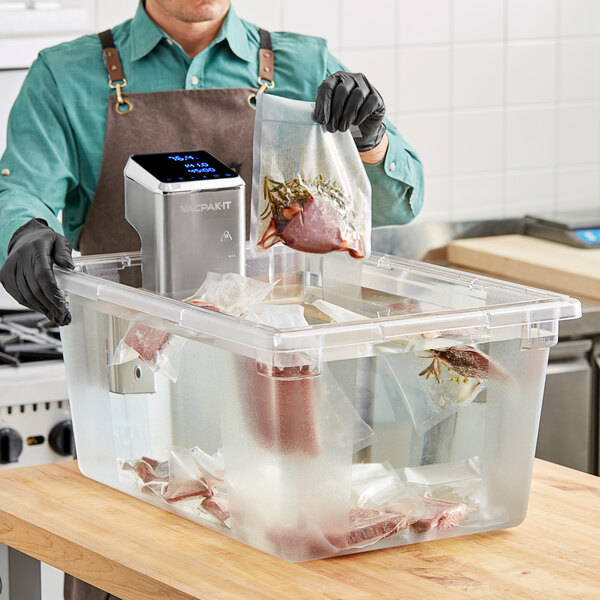
Sous vide is a precision cooking method where steak is vacuum-sealed in a bag and cooked in a water bath at a precise, controlled temperature. After the steak reaches the target temperature, it’s quickly seared in a hot pan or on a grill for a flavorful crust. The sous vide technique is ideal for thick or uneven steak cuts, allowing for precise doneness levels with unmatched precision.
Popular in high-end and high-volume settings, this method ensures edge-to-edge doneness, incredible tenderness, and near-impossible-to-overcook results. It's ideal for cooking multiple steaks at once and then searing to order. When searing after sous vide, sear on high heat for only 30 to 60 seconds per side to avoid overcooking the interior.
- Sous Vide Temperature for Steak: 130 degrees Fahrenheit for medium-rare
- How Long to Sous Vide Steak: 1 to 3 hours
- Best Steak for Sous Vide: Filet mignon, New York strip, ribeye, tomahawk, porterhouse
4. Reverse Sear
Reverse searing flips the traditional steak-cooking method: you start by slowly cooking the steak at a low temperature (in the oven or on a smoker), then finish it with a high-heat sear. This method offers several key benefits that make it a favorite amongst chefs. By slowly cooking the steak at a low temperature before finishing it with a hot sear, this method ensures even doneness from edge to center, eliminating the common issue of overcooked outer layers. It also delivers one of the best crusts of any method, as the dry surface created during the initial low-and-slow phase promotes superior browning.
Reverse searing provides excellent control and consistency over the final doneness, making it easier to achieve perfect results every time. Additionally, the gentle cooking process helps retain juices, resulting in a more tender and flavorful steak.
- Reverse Sear Oven Temperature for Steak: 225 to 275 degrees Fahrenheit
- How Long to Reverse Sear Steak: For medium-rare, cook in the oven for 20 to 40 minutes then sear for 1 to 2 minutes per side
- Best Steak for Reverse Searing: T-bone, porterhouse, New York strip, tomahawk
5. Pan Roast

A pan sear followed by an oven finish, also known as the pan roast method, is widely favored in fine dining restaurants because it offers excellent control over the steak’s internal temperature, making it easier for chefs to achieve the perfect level of doneness every time. It also creates a flavorful crust through the Maillard reaction, which enhances the steak’s texture and taste. Finishing steak in the oven is especially ideal for thick-cut steaks to avoid overcooking the exterior in the pan.
This approach is both efficient and reliable, allowing you to partially cook steaks in advance and complete the final cooking just before serving. This makes it easy to prepare several steaks ahead of the rush and finish each one as orders come in. The initial sear locks in flavor, while finishing the steak in the oven ensures even cooking throughout. This balance of precision, speed, and flavor makes pan-roasting a go-to method in steakhouses.
- Pan Roast Temperature for Steak: Sear on high then oven-finish at 400 degrees Fahrenheit
- How Long to Pan Roast Steak: For medium-rare, sear for 2 to 3 minutes per side and then finish in the oven for 4 to 6 minutes
- Best Steak for Pan Roasting: Ribeye, New York strip, filet mignon, Denver, top sirloin
6. Smoke
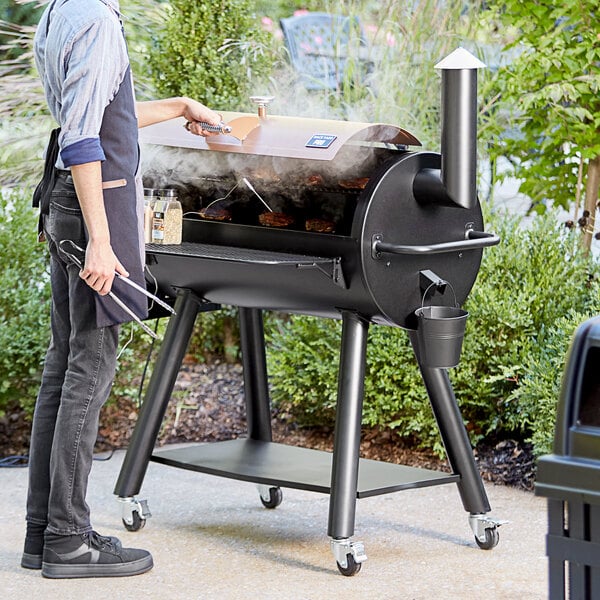
Smoking steak infuses the meat with a rich, smoky flavor while cooking it slowly over indirect heat. This method is all about depth of flavor rather than speed. The best way to smoke steak is to place it on the grates and cook until it’s about 10 to 15 degrees Fahrenheit below your target temperature, then finish with a hot sear or broil.
Since the smoke is a flavor enhancer, selecting the right wood or pellets is crucial. Opting for hardwoods such as oak, hickory, or mesquite is a solid choice, but experimenting with sweeter options like maple can introduce distinctive flavors.
- Smoker Temperature for Steak: 225 degrees Fahrenheit
- How Long to Smoke Steak: 45 to 90 minutes
- Best Steak for Smoking: Ribeye, tri-tip, porterhouse, tomahawk, and flank
7. Broil
Broiling steaks is a fast and effective method that delivers high heat from above, creating a well-seared exterior while keeping the interior juicy and flavorful. Commercial broiler ovens are equipped with powerful radiant heat elements that reach extremely high temperatures. These ovens allow chefs to cook steaks quickly and evenly, with adjustable racks to control the distance between the steak and the heat source. This method is ideal for high-volume settings where consistency and speed are essential.
Salamander broilers offer similar high-heat capabilities but in a more compact, versatile format and are often positioned above the cooking line. Broilers are often used for finishing or quickly searing steaks after sous vide or partial cooking. While not typically used to cook thick steaks from raw, they are excellent for adding a caramelized crust or reheating without overcooking the interior.
- Broil Temperature for Steak: 500 to 550 degrees Fahrenheit
- How Long to Broil Steak: 3 to 4 minutes per side for medium-rare
- Best Steak for Broiling: New York strip, ribeye, top sirloin, flank, Delmonico
No matter which method you choose, the key to a great steak lies in technique, temperature control, and most importantly, a genuine passion for the process. Let the love for a great steak be the driving force to refine each method, explore new techniques, and chase the perfect sear. Each approach has its own merits, making it worthwhile to experiment based on your taste and tools. With precise execution and a commitment to quality, any of these cooking methods can consistently produce steaks that meet the demands of a busy, high-caliber kitchen.

